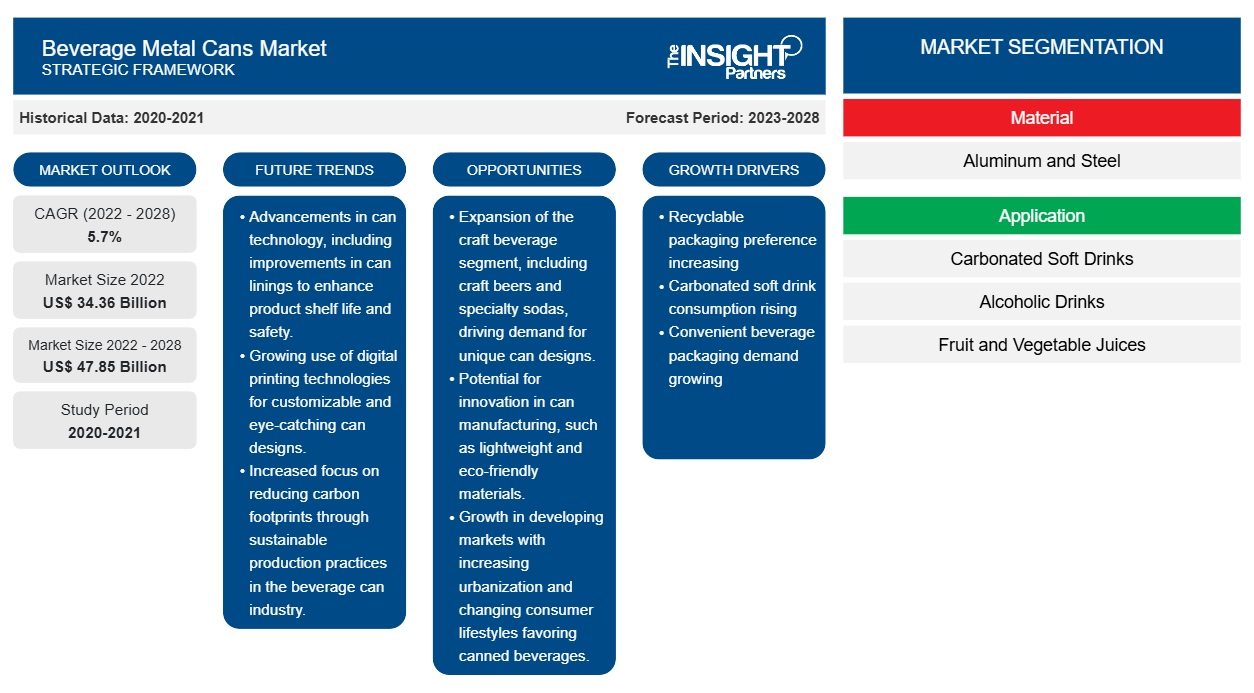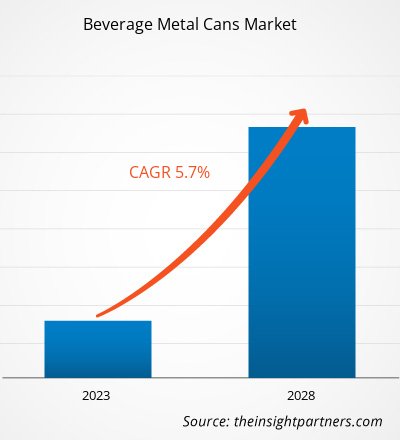Si prevede che il mercato delle lattine metalliche per bevande raggiungerà i 47.852,42 milioni di dollari entro il 2028, rispetto ai 34.363,14 milioni di dollari del 2022; si prevede una crescita a un CAGR del 5,7% nel periodo 2022-2028.
La crescita del mercato è attribuita alla rapida crescita della consapevolezza ambientale in tutto il mondo. Pertanto, vengono implementate diverse normative governative per sostituire gli imballaggi in plastica con imballaggi in metallo o vetro, riciclabili ed ecocompatibili. L'impronta di carbonio complessiva delle lattine metalliche per bevande è inferiore a quella degli imballaggi in plastica, poiché la materia prima può essere ottenuta da materiali riciclati e non richiede materie prime vergini, a differenza della plastica. Inoltre, gli imballaggi metallici sono durevoli e considerati sicuri per le applicazioni nel settore alimentare e delle bevande.
Nel 2021, il Nord America deteneva la quota maggiore del mercato globale delle lattine metalliche per bevande . Tuttavia, si stima che l'Asia-Pacifico registrerà il CAGR più elevato del mercato durante il periodo di previsione. Il mercato dell'Asia-Pacifico è segmentato in Cina, India, Giappone, Corea del Sud e Australia. Paesi come Corea del Sud, Cina e Giappone sono tra i principali mercati per alimenti e bevande. La regione ospita anche numerosi produttori di alimenti e bevande, in crescita grazie alla crescente domanda interna di bevande confezionate. La crescente produzione di bevande nella regione Asia-Pacifico e la crescente preferenza per materiali di imballaggio riciclabili contribuiranno alla crescita del mercato nella regione durante il periodo di previsione.
Otterrai la personalizzazione gratuita di qualsiasi report, incluse parti di questo report, analisi a livello nazionale, pacchetto dati Excel e potrai usufruire di fantastiche offerte e sconti per start-up e università.
Mercato delle lattine metalliche per bevande: approfondimenti strategici

-
Scopri le principali tendenze di mercato di questo rapporto.Questo campione GRATUITO includerà analisi dei dati, che spaziano dalle tendenze di mercato alle stime e alle previsioni.
Impatto della pandemia di COVID-19 sul mercato delle lattine metalliche per bevande
La pandemia di COVID-19 ha avuto un impatto significativo sul settore manifatturiero in termini di efficienza operativa a causa di lockdown prolungati in diverse regioni, chiusura di unità produttive, restrizioni su viaggi, commercio internazionale e catena di approvvigionamento e carenza di materie prime. La pandemia ha avuto un impatto negativo sul mercato a causa della chiusura di unità produttive, dell'aumento dei prezzi delle materie prime, della carenza di manodopera, dell'interruzione delle catene di approvvigionamento e dell'instabilità finanziaria. Inoltre, la crisi del settore alimentare e delle bevande dovuta al rallentamento economico causato dall'epidemia di COVID-19 ha ostacolato la crescita del mercato. Tuttavia, le imprese stanno guadagnando terreno poiché le limitazioni precedentemente imposte vengono allentate in diversi paesi. Inoltre, l'introduzione dei vaccini contro il COVID-19 da parte dei governi di diversi paesi ha ulteriormente attenuato la situazione, portando a un aumento delle attività commerciali in tutto il mondo. Infine, i governi di diversi paesi stanno pianificando di sviluppare infrastrutture moderne e tecnologicamente avanzate per mitigare l'impatto economico della pandemia. Durante il lockdown, i consumatori hanno acquistato un numero elevato di alimenti e bevande confezionati invece di articoli per la ristorazione. Pertanto, nonostante gli impatti negativi della pandemia di COVID-19, si prevede che il mercato delle lattine metalliche per bevande registrerà una crescita significativa nei prossimi anni.
Approfondimenti di mercato:
elevato consumo di bevande analcoliche gassate
Le bevande analcoliche gassate sono realizzate per soddisfare i gusti e le preferenze di gusto dei consumatori e, di recente, sono state create per essere utilizzate come bevande funzionali per i consumatori attenti alla salute.Le bevande analcoliche gassate sono diventate sempre più popolari tra i consumatori grazie al continuo lancio di nuovi gusti da parte dei produttori. La crescente domanda di prodotti "clean-label", senza glutine, ipocalorici e a basso contenuto di carboidrati ha incrementato la domanda di bevande analcoliche gassate. Le lattine di metallo sono ampiamente utilizzate come materiale di imballaggio per le bevande analcoliche gassate. I consumatori si aspettano che le bevande analcoliche appena lanciate sul mercato siano prive di ingredienti dannosi per la salute a lungo termine e promuovano la forma fisica e mentale attraverso ingredienti accuratamente selezionati. Si prevede che le bevande analcoliche a basso contenuto di zucchero e i prodotti con effetti antistress rimarranno popolari tra i consumatori. La tendenza alle bevande salutari è cresciuta in popolarità con l'espansione del settore delle bevande funzionali e la crescente attenzione alla salute dei clienti. La facile reperibilità di bevande ipocaloriche o a zero calorie sul mercato, come da Walmart e nei minimarket, ha spinto il consumo di bevande analcoliche gassate. Pertanto, l'aumento della domanda e del consumo di bevande analcoliche gassate guida la crescita del mercato delle lattine di metallo per bevande.
Approfondimenti sulle applicazioni
In base all'applicazione, il mercato globale delle lattine metalliche per bevande è segmentato in bevande analcoliche gassate, bevande alcoliche, succhi di frutta e verdura e altri. Nel 2021, il segmento delle bevande alcoliche ha rappresentato la quota di mercato maggiore. Le bevande alcoliche vengono fermentate a partire dagli zuccheri presenti in bacche, frutta, cereali e altri componenti come linfa vegetale, tuberi, miele e latte. Possono essere distillate per trasformare il liquido acquoso originale in un liquido con una gradazione alcolica notevolmente più elevata. Inoltre, la crescente domanda di contenitori portatili stimola la crescita del segmento delle bevande alcoliche. A causa delle mutevoli abitudini lavorative dei consumatori in tutto il mondo, è probabile che il mercato delle bevande alcoliche in lattina cresca. L'inscatolamento aiuta a preservare il contenuto di fibre nelle bevande, migliorandone la conservabilità senza comprometterne la qualità, rendendolo un'opzione ideale per i produttori di bevande che producono bevande con vantaggi funzionali.
Ball Corporation; Crown Holdings, Inc.; Ardagh Group SA; CANPACK; Orora Packaging Australia Pty Ltd; Amcor plc; Silgan Containers LLC; ZI Industries Limited; SHOWA DENKO KK; ed Envases GroupArdagh Group S.A.; CANPACK; Orora Packaging Australia Pty Ltd; Amcor plc; Silgan Containers LLC; ZI Industries Limited; SHOWA DENKO K.K.; and Envases Group sono tra i principali attori del mercato delle lattine metalliche per bevande. Queste aziende offrono un'ampia gamma di prodotti per il mercato. La loro presenza nelle regioni in via di sviluppo offre opportunità redditizie per la crescita del mercato delle lattine metalliche per bevande. Gli operatori del mercato stanno sviluppando prodotti innovativi e di alta qualità per soddisfare le esigenze dei clienti.
Approfondimenti regionali sul mercato delle lattine metalliche per bevande
Le tendenze e i fattori regionali che hanno influenzato il mercato delle lattine metalliche per bevande durante il periodo di previsione sono stati ampiamente spiegati dagli analisti di The Insight Partners. Questa sezione illustra anche i segmenti e la distribuzione geografica del mercato delle lattine metalliche per bevande in Nord America, Europa, Asia-Pacifico, Medio Oriente e Africa, America Meridionale e Centrale.
Ambito del rapporto di mercato sulle lattine metalliche per bevande
| Attributo del report | Dettagli |
|---|---|
| Dimensioni del mercato nel 2022 | 34,36 miliardi di dollari USA |
| Dimensioni del mercato entro il 2028 | 47,85 miliardi di dollari USA |
| CAGR globale (2022-2028) | 5,7% |
| Dati storici | 2020-2021 |
| Periodo di previsione | 2023-2028 |
| Segmenti coperti |
Per materiale
|
| Regioni e paesi coperti |
America del Nord
|
| Leader di mercato e profili aziendali chiave |
|
Densità degli operatori del mercato delle lattine metalliche per bevande: comprendere il suo impatto sulle dinamiche aziendali
Il mercato delle lattine metalliche per bevande è in rapida crescita, trainato dalla crescente domanda da parte degli utenti finali, dovuta a fattori quali l'evoluzione delle preferenze dei consumatori, i progressi tecnologici e una maggiore consapevolezza dei benefici del prodotto. Con l'aumento della domanda, le aziende stanno ampliando la propria offerta, innovando per soddisfare le esigenze dei consumatori e sfruttando le tendenze emergenti, alimentando ulteriormente la crescita del mercato.

- Ottieni una panoramica dei principali attori del mercato delle lattine metalliche per bevande
Segnala i riflettori
- Tendenze progressive del settore nel mercato delle lattine metalliche per bevande per aiutare gli operatori a sviluppare strategie efficaci a lungo termine
- Strategie di crescita aziendale adottate dai mercati sviluppati e in via di sviluppo
- Analisi quantitativa del mercato delle lattine metalliche per bevande dal 2019 al 2028
- Stima della domanda globale di lattine metalliche per bevande
- Analisi delle cinque forze di Porter per illustrare l'efficacia degli acquirenti e dei fornitori che operano nel settore
- Sviluppi recenti per comprendere lo scenario competitivo del mercato
- Tendenze e prospettive del mercato, nonché fattori che guidano e frenano la crescita del mercato delle lattine metalliche per bevande
- Assistenza nel processo decisionale evidenziando le strategie di mercato che sostengono l'interesse commerciale, portando alla crescita del mercato
- Le dimensioni del mercato delle lattine metalliche per bevande in vari nodi
- Panoramica dettagliata e segmentazione del mercato, nonché dinamiche del settore delle lattine metalliche per bevande
- Dimensioni del mercato delle lattine metalliche per bevande in varie regioni con promettenti opportunità di crescita
L'"Analisi del mercato globale delle lattine metalliche per bevande fino al 2028" è uno studio specializzato e approfondito del settore chimico e dei materiali, con particolare attenzione all'analisi delle tendenze del mercato globale delle lattine metalliche per bevande. Il rapporto mira a fornire una panoramica del mercato con una segmentazione dettagliata. Il mercato delle lattine metalliche per bevande è segmentato in base a materiale, applicazione e area geografica. Per materiale, il mercato è suddiviso in alluminio e acciaio. Per applicazione, il mercato delle lattine metalliche per bevande è suddiviso in bevande analcoliche gassate, bevande alcoliche, succhi di frutta e verdura e altri. Per area geografica, il mercato è ampiamente segmentato in Nord America, Europa, Asia-Pacifico (APAC), Medio Oriente e Africa (MEA) e Sud e Centro America.
Profili aziendali
- Ball Corporation
- Crown Holdings, Inc.
- Gruppo Ardagh SA
- CANPACK
- Orora Packaging Australia Pty Ltd
- Amcor plc
- Silgan Containers LLC
- ZI Industries Limited
- SHOWA Denko KK
- Gruppo Envases
- Analisi storica (2 anni), anno base, previsione (7 anni) con CAGR
- Analisi PEST e SWOT
- Valore/volume delle dimensioni del mercato - Globale, Regionale, Nazionale
- Industria e panorama competitivo
- Set di dati Excel
Report recenti
Rapporti correlati
Testimonianze
Motivo dell'acquisto
- Processo decisionale informato
- Comprensione delle dinamiche di mercato
- Analisi competitiva
- Analisi dei clienti
- Previsioni di mercato
- Mitigazione del rischio
- Pianificazione strategica
- Giustificazione degli investimenti
- Identificazione dei mercati emergenti
- Miglioramento delle strategie di marketing
- Aumento dell'efficienza operativa
- Allineamento alle tendenze normative






















 Ottieni un campione gratuito per - Mercato delle lattine metalliche per bevande
Ottieni un campione gratuito per - Mercato delle lattine metalliche per bevande